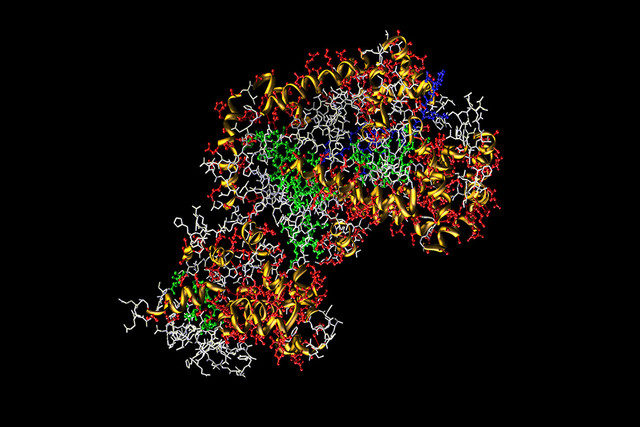
The body’s first line of defense against bacteria and viruses is the innate immune system. This protective force, present from birth, is always on alert against invaders. One brigade in this quick-response army consists of protein complexes called inflammasomes. When inflammasomes sense an infection in immune cells, they stimulate a fiery form of cell suicide called pyroptosis.
The Sloan Kettering Institute laboratory of chemical biologist Daniel Bachovchin is studying pyroptosis to tease apart the signals that trigger this vibrant type of cell death. A better understanding of the process could pave the way for developing therapies for infectious disease, cancer, and autoimmune disorders.
One inflammasome called NLRP1B has puzzled scientists for more than a decade. Previous researchers had discovered that life-threatening bacteria — notably anthrax — induce pyroptosis through NLRP1B. But the process was a mystery.
NLRP1B has a peculiar trait: Before becoming activated, it cuts itself in two and awaits a second signal. Researchers knew that anthrax can provide that signal by releasing an enzyme. Called lethal factor (LF), the enzyme directly cleaves a protein in the NLRP1B complex near one end. This somehow spurs NLRP1B to incite pyroptosis. Essentially, NLRP1B seems to serve as a “booby trap” for lethal factor and possibly other pathogen enzymes.
Both cleavages are needed to activate NLRP1B. But researchers had not been able to clarify why NLRP1B severs itself in the first place, and how LF cleavage sets the inflammasome into action.
Now Dr. Bachovchin’s team has discovered the mechanism and published the finding in Science. They studied the process in mouse cells.
After NLRP1B cuts itself in two, the halves are called the N-terminal and C-terminal fragments. The N-terminal fragment usually reins in the C-terminal fragment’s activity, stopping it from setting off the inflammatory immune response. But after the lethal factor’s release, the N-terminal fragment is “degraded,” or broken down into smaller parts. This frees the C-terminal to stimulate pyroptosis.
“Understanding the nuts and bolts of how this protein is activated is key to further understanding how the innate immune system works in general,” Dr. Bachovchin says.
An Important Signaling Pathway
The finding could shed light on diseases that don’t involve pathogens as well. “NLRP1B proteins are also mutated in autoimmune disorders,” Dr. Bachovchin explains. “It’s possible that the N-terminal fragment is degraded as a result of these mutations, setting off pyroptosis that kills normal cells and stimulates an autoimmune reaction.”
Intriguingly, Dr. Bachovchin’s team discovered that certain small-molecule drugs also activate degradation of the N-terminal fragment. One of these, Val-boroPro, has been shown to shrink tumors in mice and protect them against future cancers. However, the researchers found that the drugs don’t cause N-terminal degradation in the same way anthrax does.
“We still don’t know exactly how Val-boroPro works,” Dr. Bachovchin says. “We think NLRP1B is part of a really important signaling pathway for sensing invading microbes, in addition to anthrax, and somehow Val-boroPro mimics that pathogenic signal.”
The work sets the stage to further study this pathway and understand its role in pathogen recognition and pyroptosis.
“It shows you how the innate immune system is still full of many surprises,” Dr. Bachovchin says. “There are a lot of exciting things ahead after this discovery because we’ve just scratched the surface.”


